
Asim Waqif on bamboo, waste and capitalism
A conversation with one of the best-known contemporary Indian artists about the things we throw away and things we create
In March 2020, the Artsy online art platform named Asim Waqif (1978) one of the ten Indian artists currently shaping contemporary art – and not just within the context of his native country. Back in 2012, Waqif mounted “Bordel Monstre”, an exhibition, revolutionary in its own way, at the iconic global art scene venue that is Paris Palais de Tokyo. “At the time, there was already much talk about sustainability, eco-friendliness and a shift in thinking, but the actual approach to organising art projects did not necessarily reflect that,” the artist recalls. Asim decided to move from words to deeds. He assembled his project from materials left over from the previous show hosted by Palais de Tokyo, originally destined to end up at a garbage dump. To that, he added his own personal “rubbish”: “The work combines not just the detritus of the museum itself but also whatever the artist himself accumulated over the months he spent working on the piece. So we find ourselves inexorably drawn into a game of detectives, re-constructing his life from his empty cigarette packs, his airport luggage tags, his old receipts,” Robert Barry wrote in the Frieze Magazine at the time.
Bordel Monstre, 2012.Trash from Palais de Tokyo, Miscanthus Giganteus, electronics, mics, sensors, speakers, motors, etc. Palais de Tokyo, Paris. With the generous support of SAM Art Projects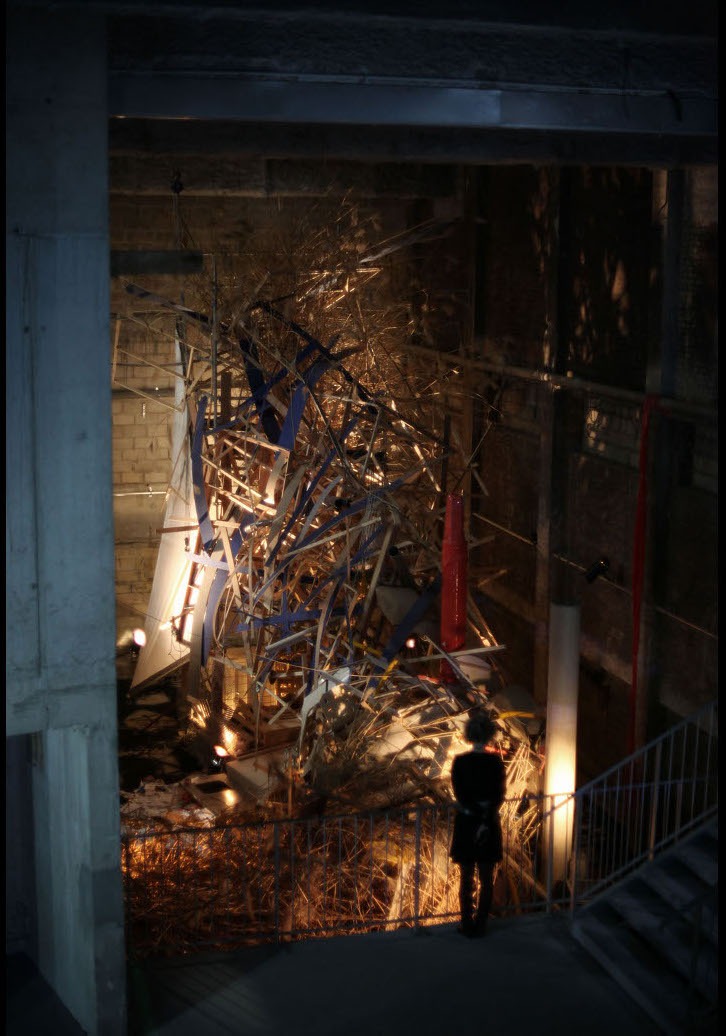
For Asim that was not just another stage in the game called ‘what is art and what can you use it to make it’ that can be traced back to the early twentieth century; it was also a conversation on the ways we live, the legacy we leave behind and the things we discard in countless garbage bins all over the world. It was raising the issue of our responsibility for these matters. Also, an attempt to reconsider our patterns of consumption. Another international project by Asim Waqif exploring these very issues was presented in 2017 in Canada, at Vancouver Art Gallery Offsite, an open-air exhibition space in the middle of the city. It was there that the artist built his “Salvage”, a structure assembled from hundreds of pieces – wooden details of demolished buildings. There was also a lot of interesting things to see inside. This is how the installation was described by Lucy Lau, a journalist from Vancouver: “Look closely and you’ll spot a wheelbarrow, abandoned doorways, and even a 1960s Kenmore washing machine nestled between the planks of wood. But to really get the most of artist Asim Waqif’s interactive installation, you’ll have to step inside. There, visitors will find all sorts of tools, trinkets, and knickknacks, including empty beer crates, vintage table fans, street signs, lanterns, and lacrosse sticks, strewn atop desks, shelves, and dressers – all of them recovered from Metro Vancouver trash.” Many of the objects on view during several months of the exhibition’s run were… appropriated by the visitors: “Eventually, by the end of the exhibition, almost everything had been stolen from there. Which I was really happy about. Something that’s been trashed, discarded, devalued in a new context appears very exotic and very desirable. And people stole it and put it back in the houses as nostalgic object,” Asim told me.
Salvage, 2017, site-specific interactive installation at Vancouver Art Gallery's Offsite. Materials from demolition sites, city landfill and North Vancouver Transfer Station. Includes Paulo's collection. Photo: Rachel Topham
Asim Waqif trained as an architect in Deli; after graduating, he spent several months working at an old-school carpenter’s workshop instead of an architect studio. He is very interested in materiality of things, particularly so in natural materials like wood, bamboo, etc. He used several species of bamboo, coir and pandan leaves to make his work for the 5th Kochi-Muziris Biennale, on view until mid-April. The twisted vortex-like structure entitled “Improvise” that has appeared in the yard of Aspinwall House, the main venue of the biennale, seems to be about to uncoil and shoot up into the sky like a giant ball of leaves, stems and roots. Meanwhile, his 20-year project “Bamsera Bamsi” in association with Samdani Art Foundation continues in Bangladesh. “I have planted 14 different species after doing careful soil conservation and fertilization using local organic resources. As the bamboo is growing, I am manipulating it into different forms to create a living, growing sculpture.”
Bamsera Bamsi. 2017 / project in association with Samdani Art Foundation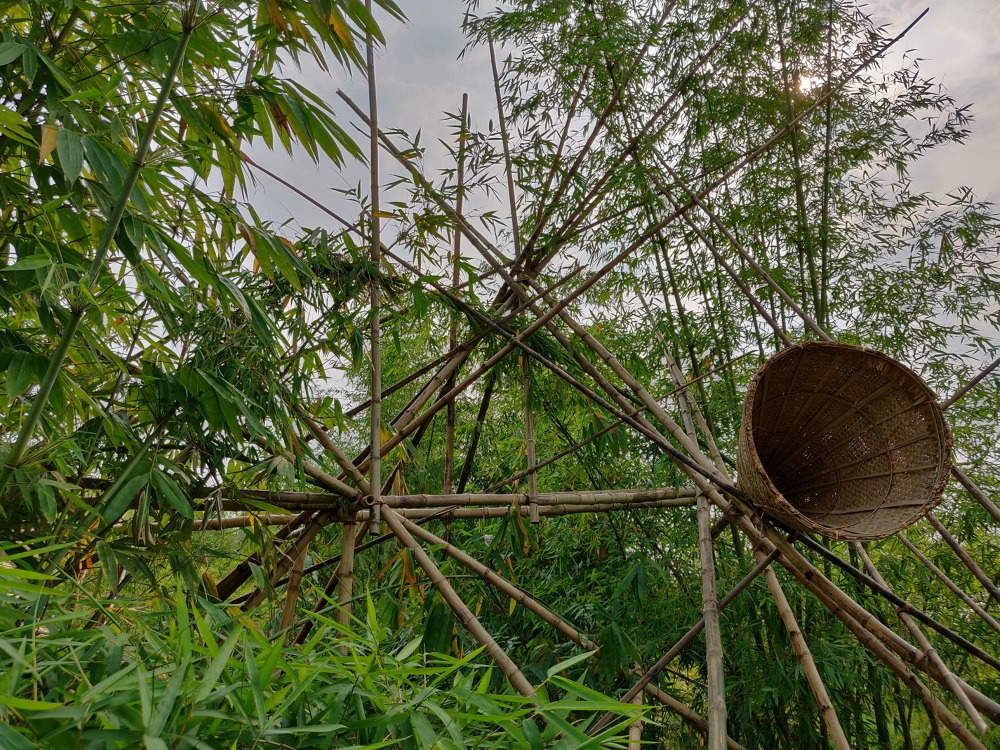
Asim consistently works at an intersection between various arts, architecture, environmental studies and design. The artist may change his approach and techniques but he apparently still believes in what he told The New York Times in 2012: “Contemporary Indian art is so disjointed from the public. It’s elitist. I want to connect with the average person in India.”
I met him in Kochi, a few days before the opening of the biennale; it was Asim who introduced many of the participating artists to each other and initiated the sometimes-difficult negotiations with the leaders of the foundation behind the art event regarding the countless problems encountered by this huge international exhibition in December 2022. I was keen to hear more about his views on the world and the potential of artistic re-examination of our ways of life and consumption. This is our conversation that took place between the morning Riga and the midday New Delhi (the time difference between the two cities is 3.5 hours).
Asim Waqif
You studied architecture in college. How did you come to choose that subject and possible future career?
When I was in school, many of my friends were preparing for what were traditionally considered as the successful careers – an engineer or doctor. They would take long long hours of extra classes and tutoring after school to study for the entrance exams, and I absolutely did not want to do that. A friend of mine and I were kind of okay at drawing, and both of us honed in on architecture as a subject that we wanted to study after school. One of my cousins was an architect and he suggested some of the best architecture colleges to apply to, so I applied to and was accepted by the School of Planning and Architecture in Delhi.
I was mostly an average student except for perhaps my last year, when I did really well. But when I experienced how an architectural office runs, I found it quite boring. A lot of the work involved making drawings of designs, whereas I was more interested in experimenting with materials with my own hands. So after I finished architecture, I apprenticed at an old-school carpentry workshop for two months, just learning woodwork. This was a really good experience for me. For the first week, before they taught me how to use the tools, they taught me how to maintain them. After a while of working with the carpenters in the way they had taught me, I would sometimes explain to them how things could be done differently. If they didn’t take heed or tried to tell me some other way to do it, I could now pick up the tool and show them how I wanted it to be done, and that completely changed my relationship with the workmen.
At that time I was doing more short-term projects, like set design for films, theatre and commercial exhibitions. I was slowly starting to learn various different skill sets, basically experimenting with different materials and different techniques. When I was making sets for advertising films and for television, everything was designed for the lens – it doesn’t matter what it looks like from the other side. So I became familiar with the camera. Then I made a few documentary films, mostly on anthropological and sociological subjects as well as on sustainability.
I never thought I’d be an artist. One of my friends was working at “Khoj”, an artist-led alternative space in Delhi. Basically, we used to go there to get the free alcohol at the openings. But then something must have clicked because I asked my friend to set up a meeting with the head of the organisation, Pooja Sood, who’s been running it for almost 20 years now. I just took some paper from her table and drew out a proposal for an installation with bamboo. Pooja was very supportive; she really encouraged me to work on the project. That’s how I did my first art project. I was continuing to do a lot of design work then, doing art only once in a while. At one point I felt that people were not really taking me seriously as an artist because they thought I was a designer or an architect who just does art from time to time. So in 2010, I made a strategic decision to start calling myself an artist. And that really dramatically changed things for me – suddenly I got some really big projects and then things went really fast.
But you also had the mind of an architect – did this in some way structure the way you look at the world, how you see potential in things?
Yeah, definitely. Architectural education is quite interesting because it has technical as well as aesthetic elements. So it’s easy to diversify and do other things after studying architecture. In fact, I would say more than half of the people who studied with me in my architecture class are not practising architecture any more – they’re doing other things. It teaches you many things, actually – for example, doing projects involves managing a large group of people. For me, structural integrity is not a big issue; I manage to do it almost instinctively. Also, I’ve been very interested in urban issues and town planning, the relationship between people and their environment, and also the built environment versus kind of organically made environments. I definitely gained some insight into all of those things because of my education in architecture.
Archaeological excavation of a 21st century Rikshaw carrying electronic waste
2014, Electronic junk and cycle rikshaw from JNU campus, buried for a few weeks and excavated as an archaeological site. With the support of Gallery Nature Morte
Architects nowadays also have to think about different kinds of sustainability – about what will happen with their objects over time. It connects us to the environmental issues such as all of the waste that is left behind after traditional construction. How did this interest in waste and rubbish as a material develop for you?
My grandmother would never throw anything away; she would use things again and again, and if its primary use was no longer feasible, she would find some other use for it. That was a value system that was very important at one time, and I think not only in India but in many parts of the world. But I find that the current economic system which dominates is actually encouraging us to throw things away so that we can buy more. During the Second World War, a lot of industry was streamlined and made efficient. More and more things could be produced in a shorter time, and with less effort and fewer resources. After the war ended, there was so much capacity for production. For example, Ford was trying to make his car production as efficient as possible, and it had become so efficient that it was not possible to make it any more efficient, at least not substantially. And everybody who could afford to have a car already had a car. Suddenly, there was a slump in the market because there was nobody left to buy new cars.
So the design industry came up with a solution called “planned obsolescence”, which basically implies putting a time-bound failure into your product. And you don’t provide easy access to replacement components so that people are forced to throw it away and buy a new thing. That’s how they created a market for themselves. Earlier, vehicles would last for 30 to 40, even 50 years. But now, vehicles are kind of designed to fail in many ways. And not only vehicles – tablets, computers, phones…
People who are more privileged, with more resources, and who are higher up in the socio-economic structure actually have a much larger garbage footprint than people who have fewer resources. That basically means that the more successful you are, the more garbage you will create. And I found that ethically problematic because I imagined that if you were more privileged, then you should be able to control the amount of waste that you create; but actually, it works the other way round.
As I said, saving things used to be a very important value to have, but now it’s been replaced by this obsession with newer models or newer things that one wants to have. That’s something that bothered me a lot. Also, I don’t know if you’ve noticed, but India has so much trash everywhere – wherever you go, there’s just trash, trash, trash, trash. There’s one place in the Himalayas called Badrinath, where I’ve been going since 1997 or so. It’s a very important pilgrimage place. Thousands and thousands of people go there every year. And all this trash just keeps accumulating over there.
That’s one of the reasons I became attracted to the idea of trash and the whole concept of a garbage bin – you just throw thing out and forget about it; you don’t think about where it’s going, what’s happening to it. I felt that a lot of things that were being thrown away actually had so much value still left in them. I started reconfiguring them, changing them, adding value to them. A completely devalued object suddenly becomes desirable, and now people want to put it in their drawing rooms or climate-controlled art collections, or wherever. That’s a bit of sarcastic criticism – the rich people who create the most trash per capita are now buying reconfigured trash from me and putting it in their houses.
Archaeological excavation of a 21st century Rikshaw carrying electronic waste
2014, Electronic junk and cycle rikshaw from JNU campus, buried for a few weeks and excavated as an archaeological site. With the support of Gallery Nature Morte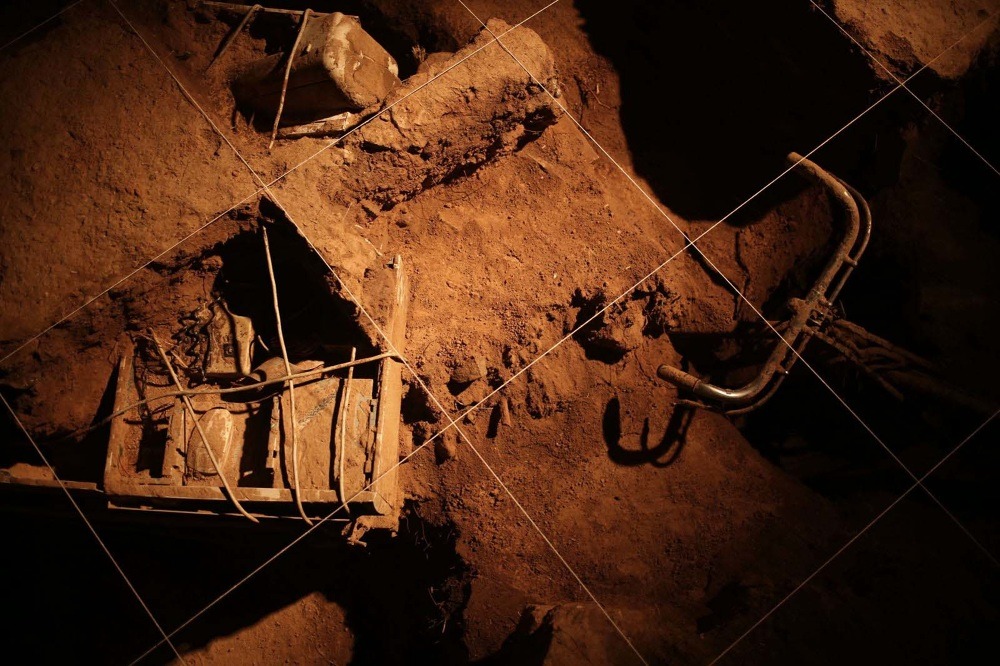
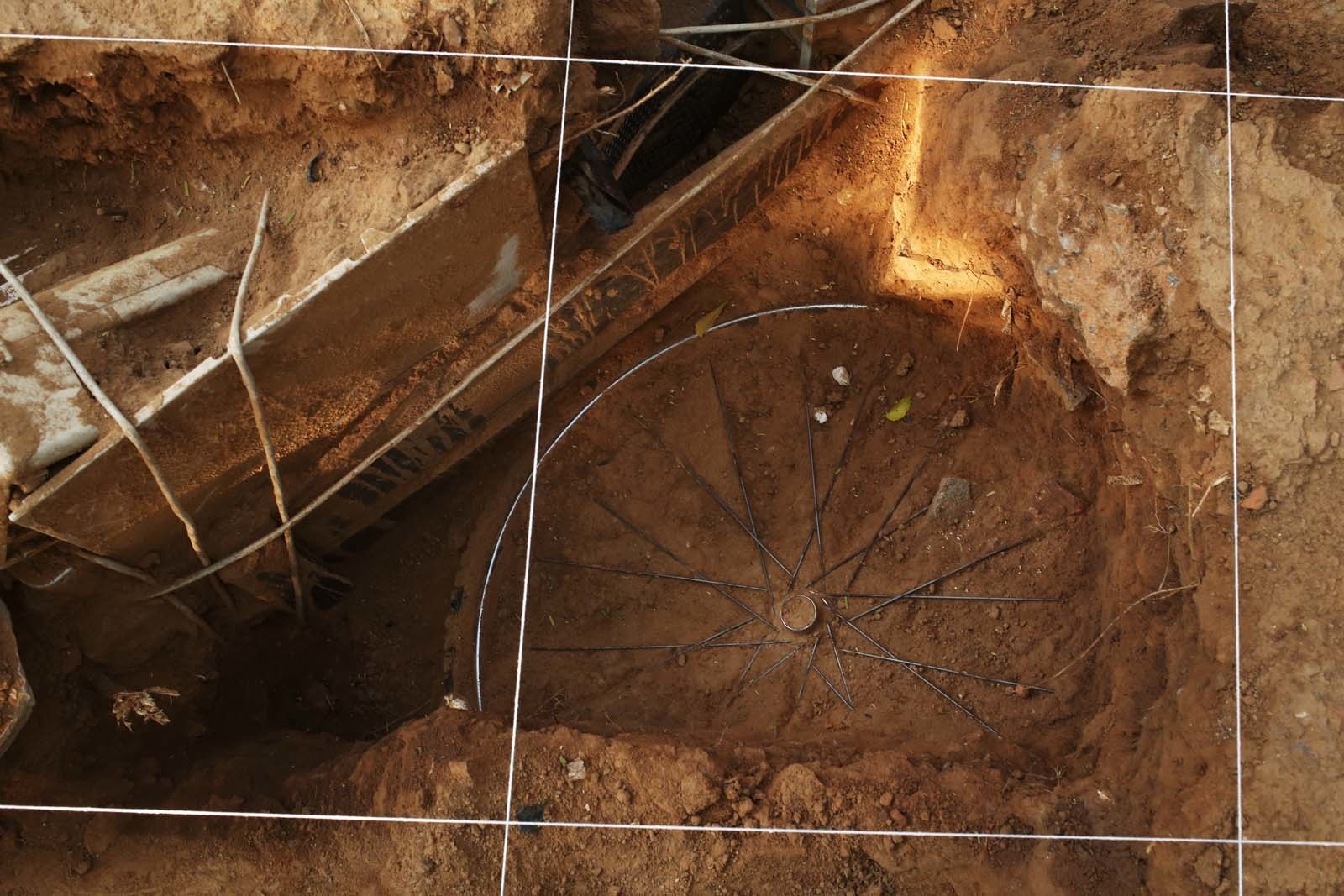
But at the same time, does it change their way of thinking? Do they understand why you are doing this? Or do they just buy it and put it in a room and that’s it?
I think it’s a mix of the two. I know that some people just buy it because now I’ve gained a bit of popularity or whatever. But still, at the same time, it’s kind of difficult to quantify the impact of things very systematically. In fact, I find that things that affect people in a subtle way have, in the long run, more potential than things that are very obvious. Because in an obvious situation, a question is raised and the answer is immediately apparent. And a person processes that information and says, Okay, this is fine, and moves on. Whereas in an ambiguous situation, an individual asks themselves questions because they’re not being provided with a very easy answer.
I try to mix things; even initially, when I started working with bamboo, I was doing kind of vernacular processes. At that time, I felt people were classifying me as a romantic traditionalist, as in: the old way was good, and the new way is bad. But I feel there are both good and bad things in new technology, the same as with the old ways. There is so much polarisation today between disparate positions, that people with different thought processes rarely sit together and discuss things or try to have any sort of conversation. It’s mostly like, I don’t agree with you, I won’t deal with you, I will not interact with you. I feel that this kind of polarisation is counterproductive because it isolates people. What I want to do is try and mix the two – the old and the new. So that both thought processes are forced to interact with each other and then we can see what works and what doesn’t.
That’s why in some of my very vernacular-looking constructions I started using robotics and interactive electronics. Visually, when you see it for the first time, you have a very nostalgic kind of interaction. But when you go inside and start exploring it, you get that it’s more contemporary, even futuristic. People find it difficult to typecast into a particular category. That makes it more interesting, I think, because then you try to understand what are the aspects of it rather than simply place it into a category and move on.
Bordel Monstre. 2012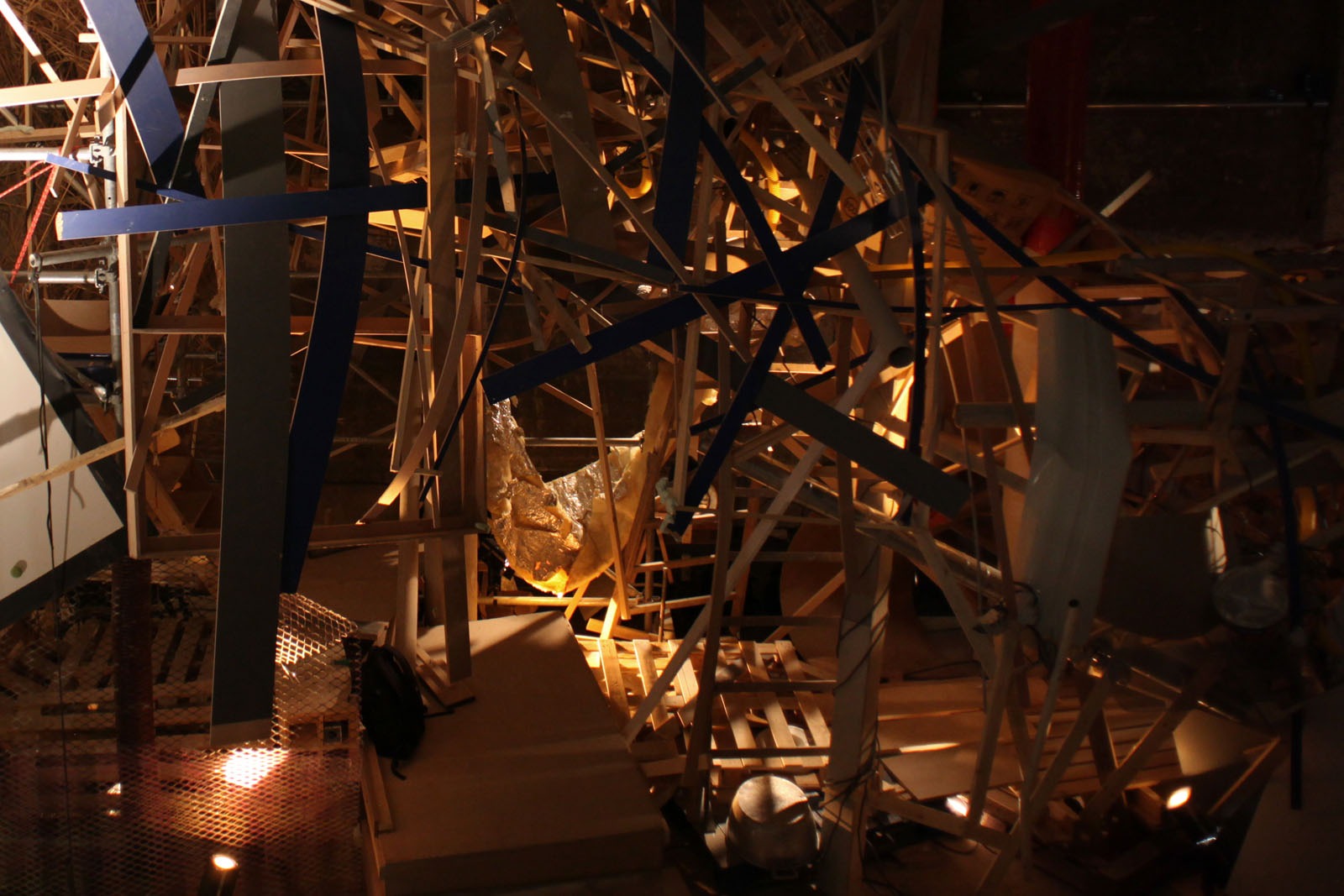
Bordel Monstre. 2012
When you were invited to make an exhibition in the Palais de Tokyo, did you already have the idea to make it from the leftovers of the previous exhibition there, or did it come to you only when you first came to the venue – a sudden insight?
I was in Paris for five months for the residency. At the end of the residency, I was supposed to do an exhibition either at the Palais de Tokyo or the Modern Art Museum opposite the Palais de Tokyo. At that time, they were still opening up many parts of the Palais de Tokyo that had never been used, and they showed me this place, like right under thePalais de Tokyo, with strange concrete pillars in the middle. It was nothing like a white cube space; most artists found it very difficult, but I actually loved that space. While I was there, I saw that there was a false wall. I went behind it and discovered that it was the back-end of the museum, full of trash from the previous exhibition that they had dismantled just a few weeks before. They were going to spend some 10,000 euros to safely discard it.
So that’s when I got the idea because I was also thinking at the time that a lot of art talks about sustainability, but quite often, the act of putting that artwork up is not very sustainable or is very high in energy usage. So I proposed to the Palais de Tokyo that they hold on to all of this waste from the previous exhibition for six more months so that my exhibition can happen, and then throw it away after that. Nobody ever asked me for a drawing of what I was going to make, which was really good. For me, that was the first time I was given such a big project with no expectation of convincing anybody about what I was going to make. Of course, there were limitations in terms of the budget and size of the project. I just completely improvised and worked on it for about two months. There was no idea what the form was going to be. I just started from one side and kept building and adding things and changing things. It was a really fun project.
dress my bitch up! 2010. Digital print on archival paper, copper, brass, wire, found object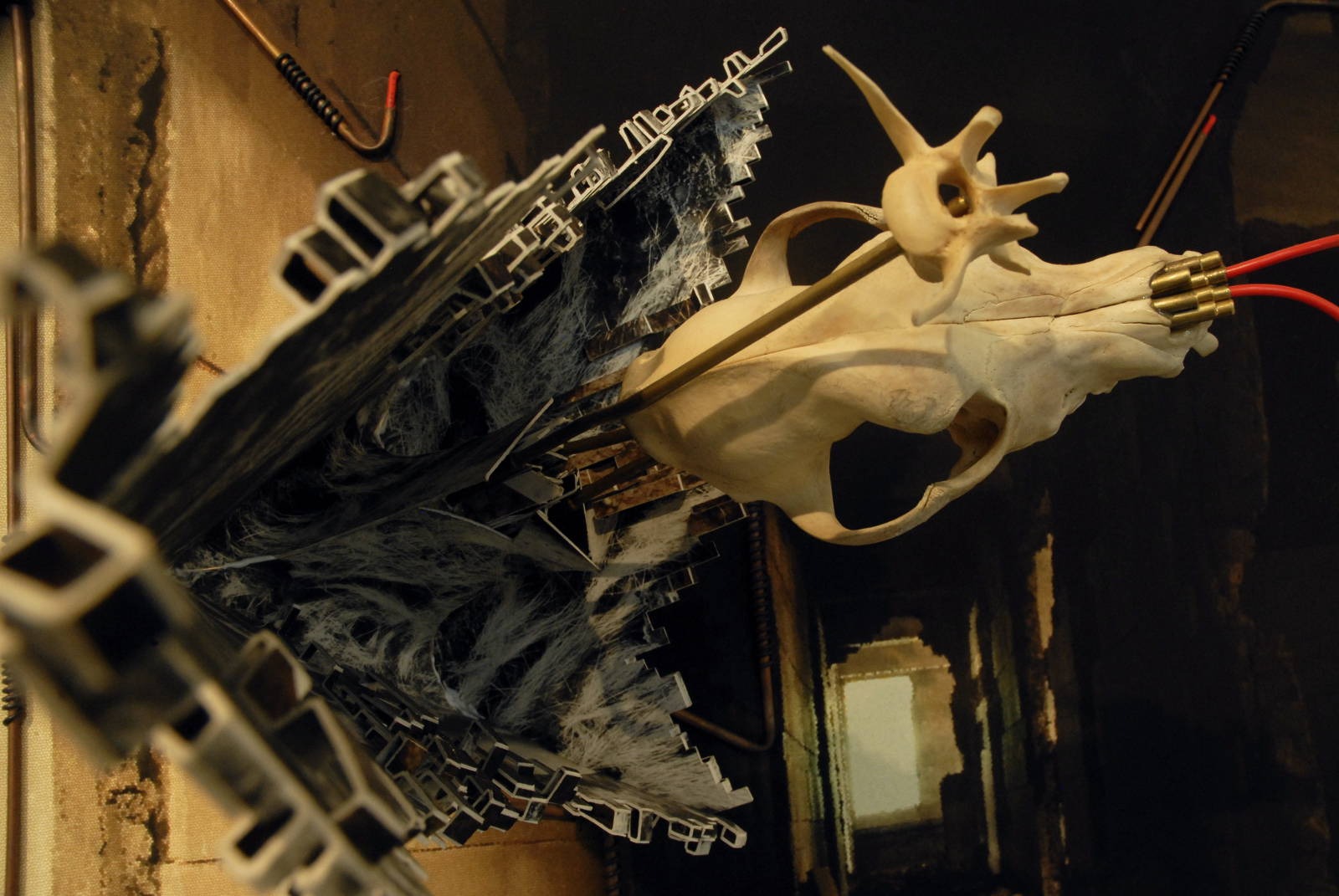
You’ve also realised a few projects in the field, which I would call an “archaeology of trash”. One of them was realised in Vancouver: you looked at the trash as also a kind of narrative about society – what exactly are people throwing away.
Leftover stuff – whatever society or civilisation used or didn’t use and threw away – becomes one of the most important pieces of evidence of how those people lived. You know, archaeologists have a very keen interest in trash. And Vancouver, at that time, was going through a crazy transformation because of the huge real estate boom there. Vancouver was being projected as the most livable town in North America in terms of its environment and living standards. A lot of the old single-family houses were acquired by property developers and small lots were being combined to make larger lots to make either condominiums or commercial buildings. The new construction was all made with very industrial materials, which are very difficult to recycle because a lot of adhesives and other chemicals are soaked into all these materials, whereas the old stuff that they were demolishing was made up of really amazing old-growth timber, which is an irreplaceable resource. There is no more old-growth timber available for use anywhere.
They said that they were doing “waste-to-energy conversion” with all the demolition waste from the old houses. They were shredding it and burning it, using the heat to generate some energy. I thought that was really, really pathetic because that was a resource that we are never again going to have in our lives. And that’s where the project started – collecting stuff from condemned houses that were going to be demolished and using that material to make something.
I was also doing a lot of research about local waste management. At one of the waste segregation centres I found that somebody had created a collection of interesting things that he had found in people’s trash over the last 15 years. He was this very quiet, unassuming kind of guy. He’d been going through what people were throwing out, and if he found it interesting, he would set it aside and research where it came from and what it was about. When I was there, coincidentally, that waste segregation centre was being shut down and a new one was being built in its place. In the new one, there would be no space for this collection that the guy had accumulated over the past 15 years. All of it was going to get trashed again – it was going to be thrown into the landfill once again. I asked him to let me use all the objects he had collected, and he agreed because he didn’t see it having any future. So we put a huge number of objects from this collection inside the installation in Vancouver – all kinds of things, like old pianos, pinball machines, etc. I was specifically looking for things that had been manufactured in and around Vancouver. We had this huge collection of objects, but the Vancouver Art Gallery, which was hosting the project, was worried that people would steal stuff from the installation. They forced me to glue everything down and fix it to the installation. Nevertheless, by the end of the exhibition, almost everything had been stolen from there. Which I was really happy about because things that been trashed, discarded and devalued, when placed into a new context, appeared very exotic and desirable. People stole them and put them back into their homes as nostalgia objects. I was very happy about that.
Salvage. 2017
Salvage. 2017
You’ve been working in this field for some time now; do you sense that people are changing their way of thinking? Are they becoming more aware of what they’re throwing away and acting more responsibly, or is it pretty much the same as it was ten years ago?
Well, it’s very complicated because as I said before about modern-day commercial economics, the dominant market force is still the same – basically, consumption is the primary model for economic growth. And consumption is a very strange thing. Even tuberculosis used to be called by the same name: “consumption” – because it completely consumes you and there’s nothing left. Right now, consumption is a very sought-after model in some way – like what I found in Vancouver, for example. Vancouver is trying to be the most eco-friendly city in North America: everybody has six separate bins for different kinds of waste: glass, plastic, organic, etc. But when I investigated deeper, I found out that very often, all of this separated waste was recombined after collection and simply dumped into a landfill.
Another example is plastic beginning to be recycled only when petroleum prices really shot up. When petroleum prices went down, it was no longer economically feasible to recycle plastic, so it would just go to the landfill. I felt at that point that this whole waste segregation mechanism was actually helping the consumption model because the user throws things in the right-coloured bin and feels they’ve done their responsibility and are now entitled to go and consume more because they’ve already done the right thing. So, I feel it’s very complicated. It’s not a simple black-and-white kind of thing. Still, people today are much more conscious, for sure. Global warming or climate change is something that, 15 years ago, only the elite was talking about. But now, even in Delhi, if I talk to a taxi driver about global warming or climate change, he knows about it.
Unfortunately, there are not that many easy ways of doing something in your own life to make the situation better. One has to work really hard to avoid the dominant market forces and live a slightly more sustainable kind of life. We are kind of stuck, but there’s definitely more awareness and people are more intentional about trying to do things in a way that is better for the environment. The question is, What more can be done? That is a really tough one. Most people find it easy to blame somebody else – e.g. it’s the government’s fault, or industry’s fault. But to bring change into your own life? That’s pretty challenging, I think.
index Residual Fear (Solo). 2018
How are you implementing greater awareness of the problem in your personal life? What are your personal attitudes to waste and garbage? Do your practices as an artist influence that?
Yes, of course they do. For instance, I put tea leaves and coffee grinds into the flower pots on my balcony instead of throwing them into the bin. Even in my apartment complex we’ve started segregating waste. Our apartment complex has a lot of trees, so there are lots of leaves. Kitchen waste by itself is a little difficult to biodegrade, but if it’s mixed with leaves, it becomes much easier. So in our district, organic waste is collected separately from dry waste. It used to be that all waste went into one bin, but now the dry waste I put out for the rubbish collectors once a week or once in two weeks is mostly only packaging and those kinds of things. They then sort and separate things and sell what they can, and get some money out of it as well. Also, my kids do some farming in a farm outside of Delhi, and we get produce back from there once the crop grows in. So, in some small ways, we are trying, for sure. But of course, there’s much more that one can do.
We started with architecture and the kind of impact it made on your career as an artist. Yet architecture has a different kind of temporality – buildings can stand for centuries, whereas artworks, if they are large-scale objects, sometimes survive only during the span of the exhibition. How do you feel about that?
Actually, if you look at vernacular architecture – for example, a house – it would only last 20 to 30 years. And then the next generation would make something that is relevant for their time. And after 20 years, the next generation would again change it to make something relevant for their time. But right now we’re stuck with very hard infrastructure; these buildings get built and then they’re there for 50 to 100 years. And then life changes, things change, but those buildings are very difficult to change – the infrastructure is very difficult to change.
Durability is very important, but sometimes small, temporary gestures or temporary acts have much more value as compared to things that last forever and ever. I don’t know if it was done subconsciously, but I ended up making a lot of projects that had a very short duration. The experience of that space or that project was embedded into people’s minds, but then the object itself was removed. Then you’re remembering things through memory or experience rather than through visiting it again and again, or seeing it again and again. The absence is also really important because when you remove something, you’re providing space for something else to take its place. I like temporality in that sense.
Improvise. 2022. Site-specific installation at the Aspinwall House. Courtesy: Kochi Biennale Foundation
Right now your object Improvise is on view in Kochi, at the main venue of the Kochi-Muziris Biennale. Will it be destroyed after the closing of the biennale in mid-April?
We’re trying to find a second life for it. One possibility is a person who wants to make an eco-friendly resort in the forest in Kerala. Maybe he will take the material and make something out of it. I do hope the material will not simply be thrown out.
Speaking about this work – could it be called a kind of “explosion of craftsmanship”? I mean, the construction itself.
Actually, frankly, I did not have very good craftsmen to work on the project. I had to train some people who usually do flooring – they lay stones on the floor in people’s houses and commercial buildings. I also taught them how to work with bamboo a bit. So the explosion that you’re talking about maybe has more to do with my frame of mind while making that project because there was a lot of anxiety and frustration while doing it. I also let that dominate the creation process in some way rather than trying to control it [laughs].
লয় [Loy]. 2019. Bamboo, cane, cloth and rope structure embedded with an interactive electronic and acoustic system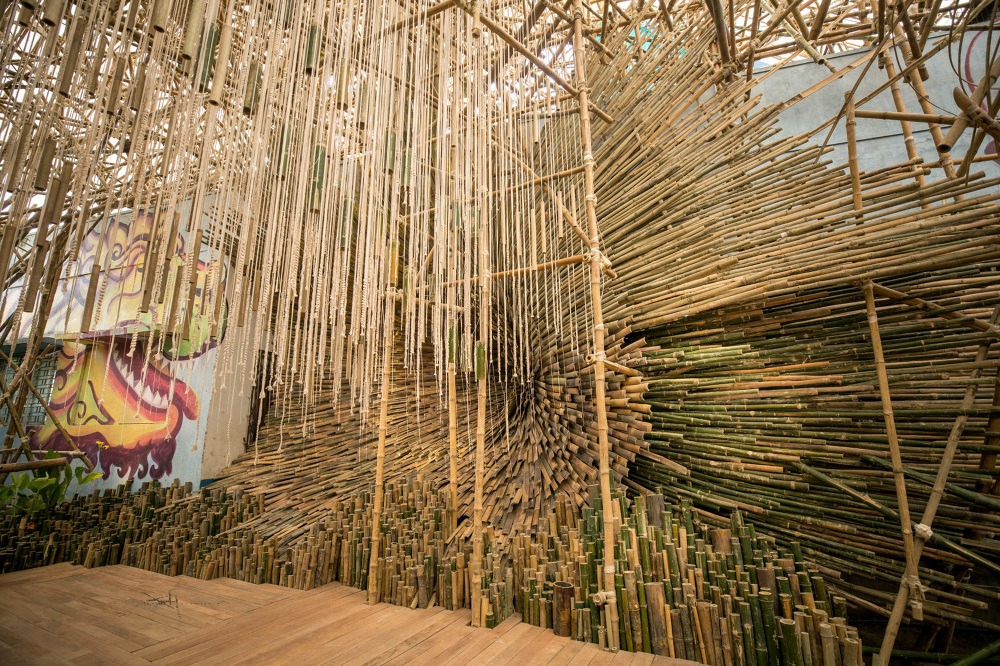
লয় [Loy]. 2019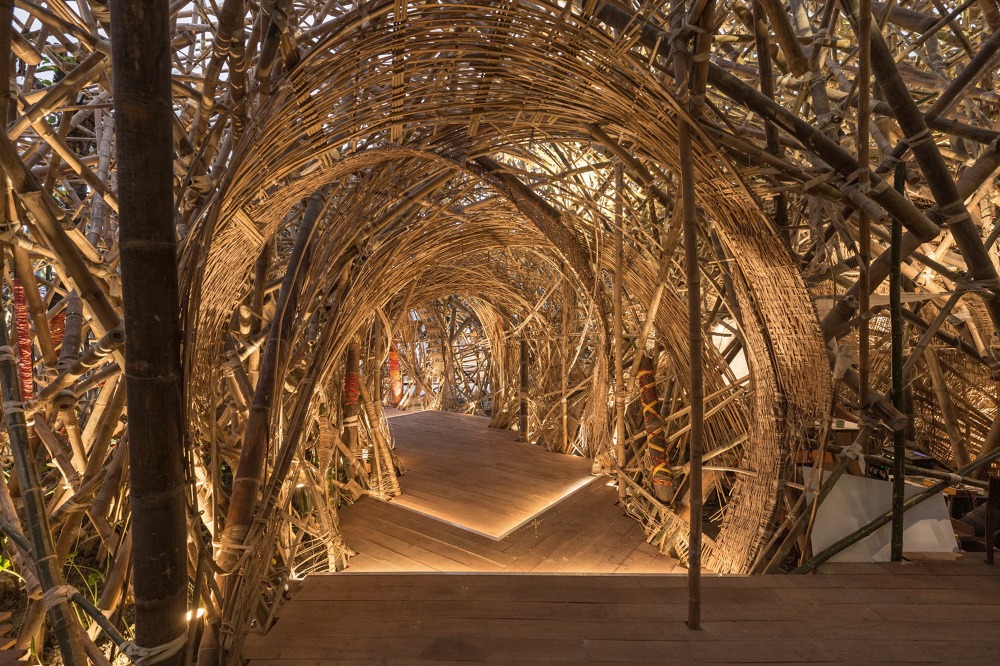
How do you feel when working with natural materials, bamboo and other things which were plants (or were made from plants)? Is their structure an aid or a hindrance?
Bamboo, specifically in India, has a very rich historical perspective. A lot of work has been done with bamboo for hundreds and thousands of years, including the building of bridges and houses, and the making of cutlery, baskets, small craft objects, cooking utensils, and so on. Bamboo also became a very important raw material for making paper, so a lot of it has been propagated just for making paper. But most people who are really good craftsmen of bamboo are actually running away from it. They, for example, don’t want the younger generation to work with bamboo; they’d rather have them do something else. While the elite – if you look at boutique design studios in Delhi, Bombay, or Europe – are looking at bamboo as a very amazing, exotic and sustainable material. There is a huge disparity between these two viewpoints, and I want to try and bridge that in some way.
Another aspect: contemporary architecture right now is really celebrating parametric forms inspired by nature – from looking at organic systems. But more often than not, most design studios working on parametric architecture use 3D-printers, algorithms, and CAD environments to generate these parametric forms. Whereas I find that in weaving and basketry, the parametric nature is an essential part of that process. I want to try and use that craft process to arrive at these parametric forms, which are right now really trending...it’s another kind of geometry experiment I have going on. Basketry is usually very small and the objects are meant as containers. I’m trying to see how that process can be scaled up. From containers, it can become an architectural space containing a volume of space rather than just some things.
Bamsera Bamsi. 2017 / project in association with Samdani Art Foundation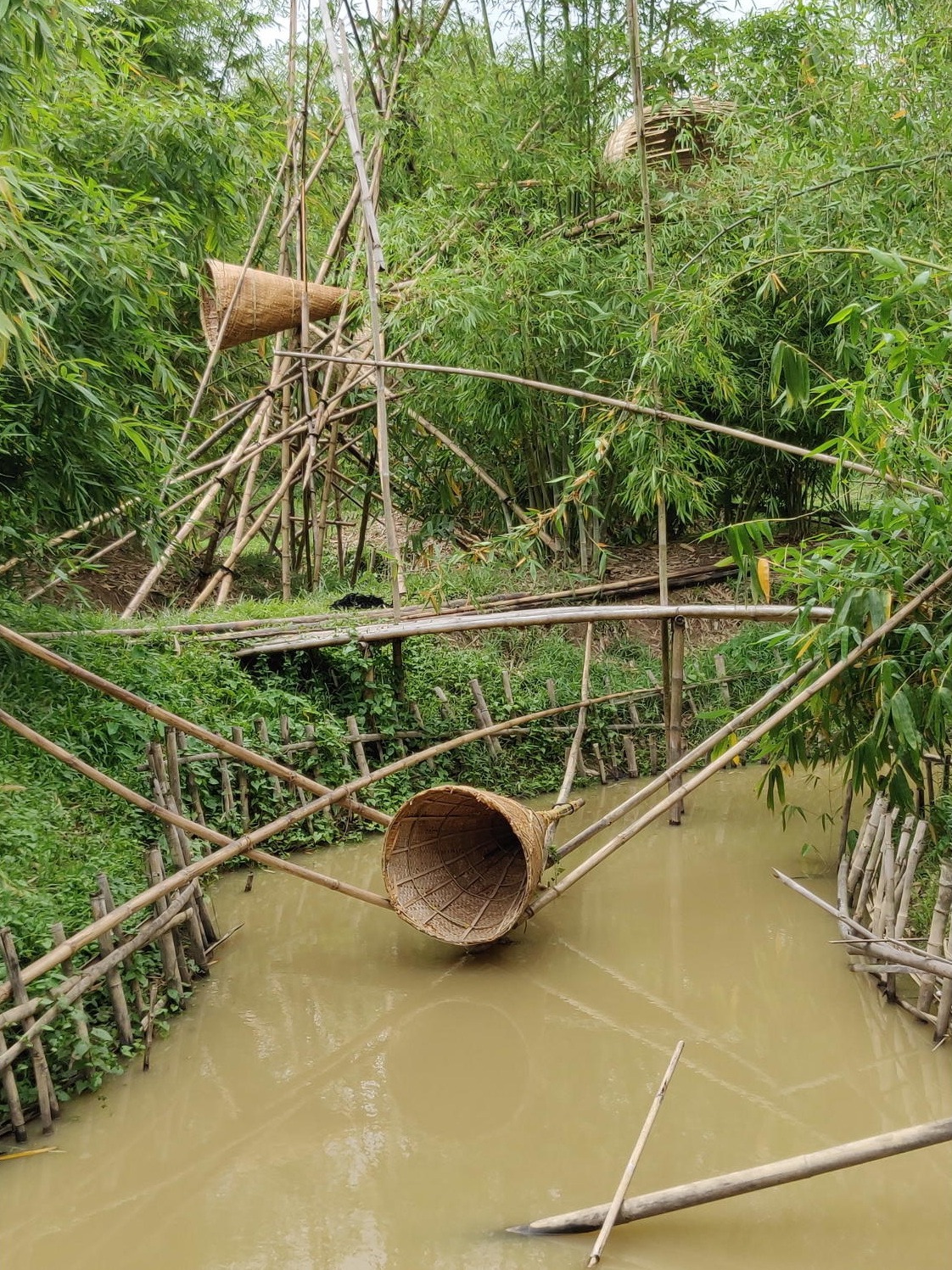
Are you still working on the project in Bangladesh – the very long-term project in which you are trying to create living, growing sculptures from bamboo?
Yes, that’s going on. For six years now. Unfortunately, in 2020 and 2021 I couldn’t go because of the pandemic and travel restrictions. But I was trying to manage it through messages and WhatsApp. And in some strange way, that lack of activity in the last two years has been a good thing because that bamboo that I’m growing is now really flourishing. I didn’t get a chance to do much of the intrusive stuff I had been thinking about. Speaking about the inspiration for the project: there are these ficus bridges that are made in some parts of India close to Bangladesh. The roots of these ficus trees are trained to go from one side of the stream to the other side. These bridges take from 70 to 150 years to make. It’s a very slow process: the person who starts making the bridge…maybe his grandchild will be able to use it.
So I proposed a 20-year project. For the first 15 years I want to just experiment, fool around, try different things. And the last five years I’ll spend on making it become a self-running system for a longer period of time than my involvement. I’m trying lots of different things over there besides the growing of bamboo – we did a lot of research on the local species of bamboo and also some species that we want to introduce. And different ways of propagating bamboo, since bamboo doesn’t flower very often. The land we have at our disposal was actually used for rice cultivation, so it’s gently terraced. It was designed to flood when it rains – water would accumulate there because that’s what rice needs to grow. But bamboo doesn’t really like water that much, or rather, it likes to be close to water but higher than the water level, never submerged. I wanted to make some mounds in this area to grow the bamboo on, so instead of getting soil from somewhere else, I dug a lake and used the soil from that to make the mounds; now we have the ideal location for bamboo. Then we used grass from the surrounding area to support this soil so it doesn’t erode with rain. We used cow dung from a local dairy farm to fertilise the soil. Because we have a lake, we also put some fish in it and automatically got frogs and snakes as well as lots of birds, and in April and May we’re getting a lot of fireflies. As it’s growing, I’m manipulating some of the green bamboo into different forms and also using some harvested bamboo to supplement those forms. The other thing I’m trying out there are wind-driven musical instruments. So depending on the season and wind direction, you get different soundscapes.
Bamsera Bamsi. 2017 / project in association with Samdani Art Foundation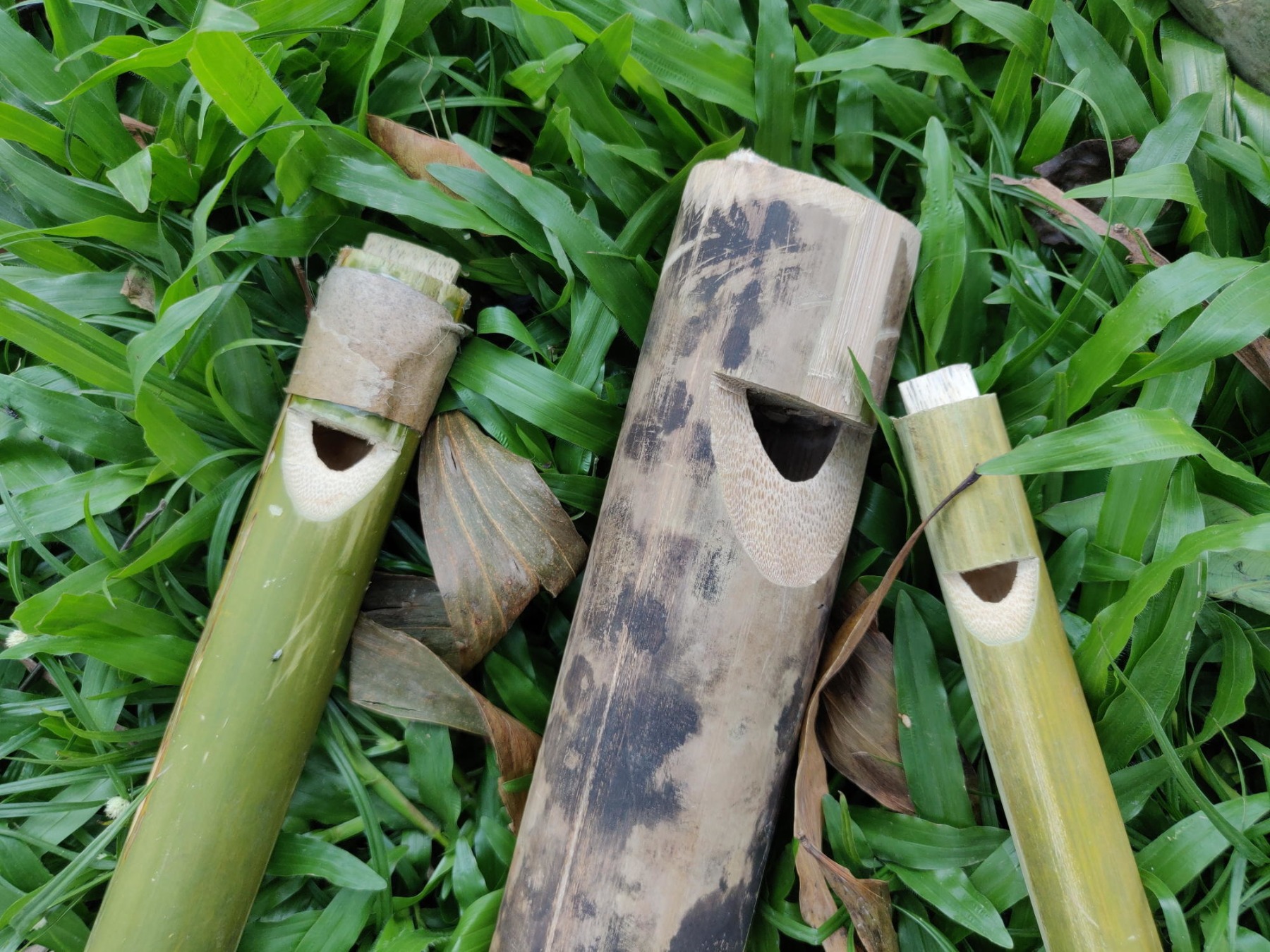
Sounds like you are making a small bamboo paradise…
The interesting thing about it is that there is no fixed end-goal. And I go every year with an open mind. Next time I’m hoping to take some musicians, friends of mine, and collaborate with them on musical instruments to install there. This is a totally open-ended project. I don’t know where it’s going. But it’s fun.